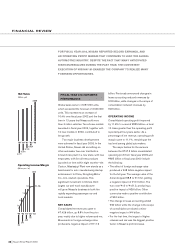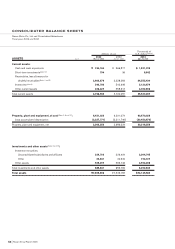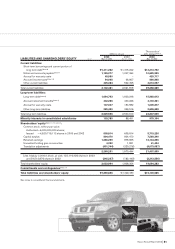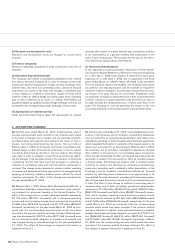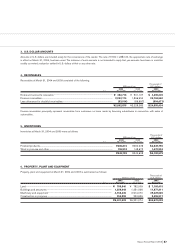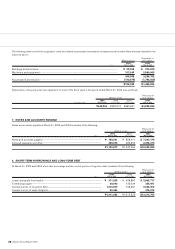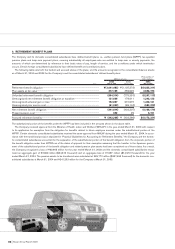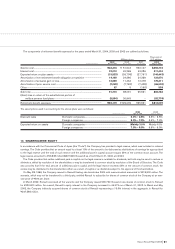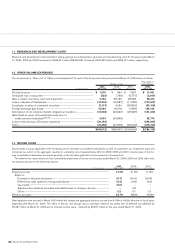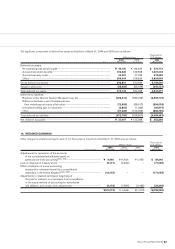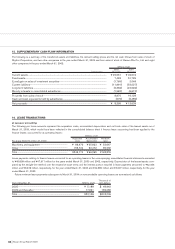Nissan 2004 Annual Report Download - page 58
Download and view the complete annual report
Please find page 58 of the 2004 Nissan annual report below. You can navigate through the pages in the report by either clicking on the pages listed below, or by using the keyword search tool below to find specific information within the annual report.
Nissan Annual Report 2003
56
(k) Research and development costs
Research and development costs are charged to income when
incurred.
(l) Revenue recognition
Revenue is generally recognized on sales of products at the time of
shipment.
(m) Derivative financial instruments
The Company and certain consolidated subsidiaries have entered
into various derivative transactions in order to manage certain risks
arising from adverse fluctuations in foreign currency exchange rates,
interest rates, and stock and commodity prices. Derivative financial
instruments are carried at fair value with changes in unrealized gain
or loss charged or credited to operations, except for those which
meet the criteria for deferral hedge accounting under which unrealized
gain or loss is deferred as an asset or a liability. Receivables and
payables hedged by qualified forward foreign exchange contracts are
translated at the corresponding foreign exchange contract rates.
(n) Appropriation of retained earnings
Under the Commercial Code of Japan, the appropriation of retained
earnings with respect to a given financial year is made by resolution
of the shareholders at a general meeting held subsequent to the
close of such financial year. The accounts for that year do not, there-
fore, reflect such appropriations. See Note 22.
(o) New Accounting Standards
A new Japanese accounting standard “Impairment of Fixed Assets”
was issued in August 2002 that is effective for fiscal years beginning
on or after April 1, 2005. Early adoption is allowed from fiscal years
beginning on or after April 1, 2004 and an application from fiscal
years ending March 31, 2004 to March 30, 2005 is also permitted.
The new standard requires that tangible and intangible fixed assets
be carried at cost less depreciation, and be reviewed for impairment
whenever events or changes in circumstances indicate that the carry-
ing amount of an asset may not be recoverable. Companies would
be required to recognize an impairment loss in their income statement
if certain indicators of asset impairment exist and the book value of
an asset exceeds the undiscounted sum of future cash flows of the
asset. The Company is currently assessing the impact of this new
accounting standard on its financial position and operating results.
2. ACCOUNTING CHANGES
(a) Until the year ended March 31, 2003, finished goods, work in
process and purchased parts included in raw materials were stated
at the lower of average cost or market, and raw materials except for
purchased parts and supplies were stated at the lower of cost or
market, cost being determined by the last-in, first-out method.
Effective April 1, 2003, the Company and certain consolidated sub-
sidiaries began to value all inventories at the lower of cost or market,
cost being determined by the first-in, first-out method. This change
was made in order to establish a sound financial position by reflect-
ing the changes in the purchase prices in the valuation of inventories
considering the fact that there has been progress in achieving a
reduction in purchasing costs and that this trend is anticipated to
continue. This change is also intended to achieve a better matching
of revenue and expenses and more appropriate cost management by
applying an inventory valuation method which reflects the actual
inventory movements. The effect of this change was immaterial for
the year ended March 31, 2004.
(b) Effective April 1, 2003, Nissan Motor Manufacturing (UK) Ltd., a
consolidated subsidiary, implemented early adoption a new account-
ing standard for retirement benefits in the United Kingdom. The
effect of this change was to increase retirement benefit expenses by
¥2,178 million ($20,547 thousand), and to decrease operating
income and income before income taxes and minority interests by
¥1,686 million ($15,906 thousand) and ¥2,178 million ($20,547
thousand), respectively, for the year ended March 31, 2004 as com-
pared with the corresponding amounts which would have been
recorded if the previous method had been followed. Retained earn-
ings also decreased by ¥18,132 million ($171,056 thousand) since
the net retirement benefit obligation at transition and actuarial loss
was charged directly to retained earnings for the year ended March
31, 2004. The effect of this change on segment information is
explained in Note 21.
(c) Until the year ended March 31, 2003, noncancelable lease trans-
actions of the Company and its domestic consolidated subsidiaries
were accounted for as operating leases (whether such leases were
classified as operating or finance leases) except that lease agreements
which stipulated the transfer of ownership of the leased assets to the
lessee were accounted for as finance leases. Effective April 1, 2003,
the Company and its domestic consolidated subsidiaries changed
their method of accounting for noncancelable lease transactions
which transfer substantially all risks and rewards associated with the
ownership of assets, from accounting for them as operating leases,
to finance leases. This change was made in order to achieve a better
matching of revenue and expenses by calculating manufacturing
costs more accurately and to establish a better presentation of the
Company’s and its domestic consolidated subsidiaries’ financial
position by reflecting lease transactions more appropriately in its
consolidated financial statements, considering the increasing materi-
ality of these lease transactions as well as from an international point
of view. The effect of this change in method of accounting was to
decrease sales, cost of sales and selling, general and administrative
expenses by ¥17,943 million ($169,274 thousand), ¥38,910 million
($367,075 thousand) and ¥624 million ($5,887 thousand), respec-
tively, and to increase operating income and income before income
taxes and minority interests by ¥21,591 million ($203,689 thousand)
and ¥17,659 million ($166,594 thousand), respectively, for the year
ended March 31, 2004 as compared with the corresponding
amounts which would have been recorded if the previous method
had been followed. In addition, trade and sales finance receivables,
tangible fixed assets and lease obligation increased by ¥70,670 mil-
lion ($666,698 thousand), ¥66,514 million ($627,491 thousand)
and ¥120,061 million ($1,132,651 thousand), respectively, at March
31, 2004 over the corresponding amounts which would have been
recorded if the previous method had been followed. The effect of
this change on segment information is explained in Note 21.


